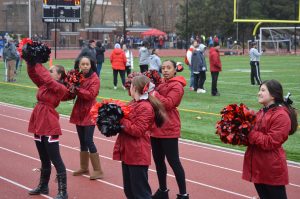
[ad_1]
 Wellesley High School Athletic Director John Brown at this past week’s School Committee meeting gave an update on the upcoming fall sports season. Or make that “fall 1” sports season, for starters.
Wellesley High School Athletic Director John Brown at this past week’s School Committee meeting gave an update on the upcoming fall sports season. Or make that “fall 1” sports season, for starters.
(Brown starts speaking just before the 1-hour mark of the Wellesley Media recording of the School Committee meeting.)
While the school and local sports governing authorities continue to fine tune plans, the Massachusetts Interscholastic Athletic Association (MIAA) did release its guidance for modifications to fall sports a few days after Brown spoke. The state’s Office of Energy and Environmental Affairs also has issued guidance for athletes from young children to adults.
As he indicated during the meeting, fall sports for high school can’t start before Sept. 18 in light of the start of school getting pushed out to Sept. 16. That season will go until the end of November.
What’s more, there will be no football or cheerleading during the initial fall season, as they have been deemed “high-risk sports” based on the close contact required between participants. The season won’t include any season-ending state tournaments this fall, in an effort to minimize travel and interactions among many teams. The winter season will run from the end of November until the end of February. A second fall season (“fall 2”) will be wedged in between Feb.22-April 25, and that’s when football and cheerleading could be allowed (assuming Wellesley Public Schools Supt. David Lussier orders a dome, Brown joked). The spring season will finish out the school year.
Most sports will be conducted with modified rules, which will result in the sports resembling their old selves more or less depending on the risk-level of the sports. Soccer players will still get to use their feet, kick balls, and attempt to score or defend, but they won’t be allowed to make throw-ins, corner kicks, or intentional headers. Cross country runners will be discouraged from running in packs, and races will involve staggered starts. No handshakes, etc., will be allowed as part of social distancing practices.
“One of the things we’ve said right along is that we want to play sports, we want to play them safely,” Brown said. “We also need to know there are going to be some changes. Sports may not look like we normally have them. That’s a concern.”
Soccer, field hockey, swimming & diving and volleyball are all considered medium-risk sports, and there’s already been talk of squeezing volleyball into the fall 2 season to limit outside students from entering school buildings that might not yet even be open to local students. Gyms may also be used instead for lunches, classes, or other purposes.
As student-athletes ready for their seasons, Brown stressed that the school doesn’t recognize or condone captains’ practices. He also noted that while the MIAA has relaxed rules about coaches coaching athletes out of season, the town has concerns about allowing this.
Next up is figuring out schedules, which Brown says is made a bit less complicated given that there are currently no high-risk communities in Wellesley’s conferences. A likely scenario would feature Wellesley playing home and away games or meets with the same school in the same week.
As schedules shape up, some students might eye the rare opportunity to play all four seasons.
“We’ve got a lot of three-sport athletes. We now can have four-sport athletes…” he says. “…which is something that not many kids could say that they did.”
[ad_2]
Source link
